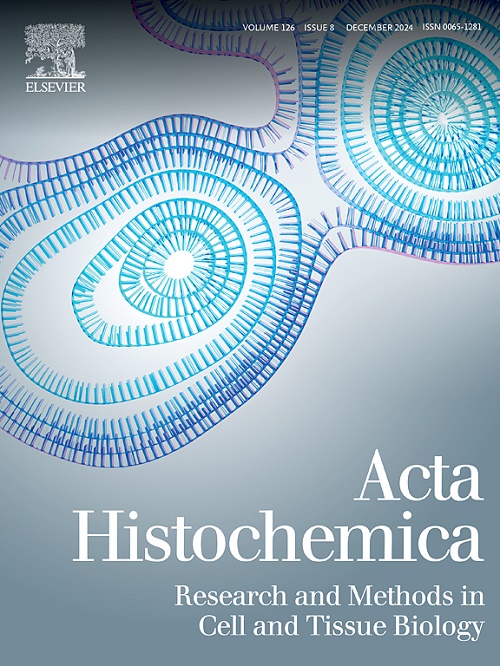Inducible gankyrin overexpression drives hepatocarcinogenesis in a liver-specific zebrafish model
IF 2.4
4区 生物学
Q4 CELL BIOLOGY
引用次数: 0
Abstract
Background
Hepatocarcinogenesis is a complex, multistep process that begins with fatty liver, progresses to fibrosis, and ultimately leads to cancer. Numerous etiological factors contribute to this progression, highlighting the importance of developing animal models to facilitate both basic and translational research aimed at discovering new therapeutic strategies. Gankyrin is a key oncoprotein involved in the genetic regulation of liver pathology.
Material and method
To investigate its oncogenic role without the need for cancer cell inoculation or drug treatment, we employed a Tet-On system to drive zebrafish gankyrin overexpression in hepatocytes under the control of the fabp10a promoter. Results: After eight weeks of induction, fabp10a:eGFP-gankyrin transgenic zebrafish spontaneously developed persistent hyperplasia, bile duct hyperplasia, and hepatocellular carcinoma (HCC), demonstrating the oncogenic potential of gankyrin in liver tumorigenesis. In this study, we demonstrate that gankyrin activation drives the progressive development of HCC in zebrafish. Liver-specific overexpression of gankyrin in wild-type zebrafish led to hyperplasia, bile duct hyperplasia, and HCC, establishing a robust zebrafish model for studying liver cancer. Our findings highlight the utility of this model for investigating the molecular mechanisms underlying tumorigenesis.
Conclusion
This study establishes a robust zebrafish model in which liver-specific overexpression of gankyrin induces spontaneous progression from hyperplasia to hepatocellular carcinoma. The model provides a valuable platform for investigating the molecular mechanisms of hepatocarcinogenesis and exploring potential therapeutic strategies.
在肝脏特异性斑马鱼模型中诱导gankyrin过表达驱动肝癌发生
肝癌的发生是一个复杂的多步骤过程,从脂肪肝开始,发展到纤维化,最终导致癌症。许多病因因素促成了这一进展,强调了开发动物模型以促进旨在发现新的治疗策略的基础和转化研究的重要性。Gankyrin是参与肝脏病理遗传调控的关键癌蛋白。材料和方法为了研究其在不需要癌细胞接种或药物治疗的情况下的致癌作用,我们采用Tet-On系统在fabp10a启动子的控制下驱动斑马鱼肝细胞中gankyrin的过表达。结果:诱导8周后,转基因fabp10a:eGFP-gankyrin斑马鱼自发发生持续性增生、胆管增生和肝细胞癌(HCC),显示了gankyrin在肝脏肿瘤发生中的致癌潜力。在这项研究中,我们证明了gankyrin激活推动了斑马鱼HCC的进行性发展。野生型斑马鱼肝脏特异性过表达gankyrin导致增生、胆管增生和HCC,为研究肝癌建立了稳健的斑马鱼模型。我们的研究结果强调了该模型在研究肿瘤发生的分子机制方面的实用性。结论本研究建立了一个稳健的斑马鱼模型,在该模型中肝脏特异性过表达gankyrin可诱导从增生到肝细胞癌的自发进展。该模型为研究肝癌发生的分子机制和探索潜在的治疗策略提供了一个有价值的平台。
本文章由计算机程序翻译,如有差异,请以英文原文为准。
求助全文
约1分钟内获得全文
求助全文
来源期刊

Acta histochemica
生物-细胞生物学
CiteScore
4.60
自引率
4.00%
发文量
107
审稿时长
23 days
期刊介绍:
Acta histochemica, a journal of structural biochemistry of cells and tissues, publishes original research articles, short communications, reviews, letters to the editor, meeting reports and abstracts of meetings. The aim of the journal is to provide a forum for the cytochemical and histochemical research community in the life sciences, including cell biology, biotechnology, neurobiology, immunobiology, pathology, pharmacology, botany, zoology and environmental and toxicological research. The journal focuses on new developments in cytochemistry and histochemistry and their applications. Manuscripts reporting on studies of living cells and tissues are particularly welcome. Understanding the complexity of cells and tissues, i.e. their biocomplexity and biodiversity, is a major goal of the journal and reports on this topic are especially encouraged. Original research articles, short communications and reviews that report on new developments in cytochemistry and histochemistry are welcomed, especially when molecular biology is combined with the use of advanced microscopical techniques including image analysis and cytometry. Letters to the editor should comment or interpret previously published articles in the journal to trigger scientific discussions. Meeting reports are considered to be very important publications in the journal because they are excellent opportunities to present state-of-the-art overviews of fields in research where the developments are fast and hard to follow. Authors of meeting reports should consult the editors before writing a report. The editorial policy of the editors and the editorial board is rapid publication. Once a manuscript is received by one of the editors, an editorial decision about acceptance, revision or rejection will be taken within a month. It is the aim of the publishers to have a manuscript published within three months after the manuscript has been accepted
 求助内容:
求助内容: 应助结果提醒方式:
应助结果提醒方式:


